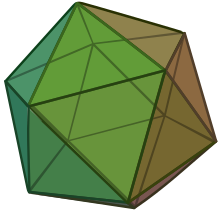
Back دلتاوي السطوح Arabic Делтаедър Bulgarian Deltaedre Catalan Deltaeder German Δελτάεδρο Greek Egallatera trianguledra pluredro Esperanto Deltaedro Spanish Deltaèdre French Դելտաէդր Armenian Deltahedron ID


In geometry, a deltahedron (plural deltahedra) is a polyhedron whose faces are all (congruent) equilateral triangles. The name is taken from the Greek upper case delta letter (Δ), which has the shape of an equilateral triangle. There are infinitely many deltahedra. By the handshaking lemma, each deltahedron has an even number of faces. Only eight deltahedra are strictly convex; these have 4, 6, 8, 10, 12, 14, 16, and 20 faces.[1] These eight deltahedra, with their respective numbers of faces, edges, and vertices, are listed below.
- ^ Freudenthal, H; van der Waerden, B. L. (1947), "Over een bewering van Euclides ("On an Assertion of Euclid")", Simon Stevin (in Dutch), 25: 115–128 (They showed that there are just eight strictly convex deltahedra.)
© MMXXIII Rich X Search. We shall prevail. All rights reserved. Rich X Search